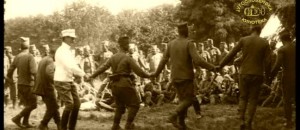Dyoka Bogdanović was no newcomer to cinema. Born to a lawyer’s family in 1860, he set up Belgrade’s first movie theatres in 1905. The experience of the First Balkan War (1912–1913) led him to the idea of re-enacting Serbian victories for the camera. In order to realise this plan, Bogdanović contracted two camera operators who were working for the Vienna outpost of Pathé, Europe’s leading producer of newsreels.
In the midst of the filming preparations in June 1913, Bulgaria attacked Serbia and Greece, thus unleashing the Second Balkan War. Bogdanović immediately understood that this was his chance to film real combat operations instead of re-enacted ones. He decided to abandon his original plans and send his camera operators to the front. During the month of July, the men – whose names are unknown even today – shot footage of battles, of devastated villages, of war victims, of prisoners of war, and of soldiers in their everyday life. Out of this footage, Bogdanović quickly compiled a number of short documentaries and newsreels. These films are noteworthy not only because few other moving images of the Second Balkan War exist, but also because they rank among the earliest cinematic recordings showing soldiers in action in real war situations.
As part of the EFG1914 project, the Jugoslovenska Kinoteka has made some of these silent films available on the European Film Gateway. One of them, Pukovnik Nedić u borbi (Battle of the Black Stone), shows an artillery unit in various parts of its mission. Another one, Vojska na Banjici (Life of Serbian Soldiers in Banyitsa Army Camp), is remarkable for depicting soldiers performing a folk-dance in their free time.
When the First World War broke out in 1914, Bogdanović took up war reporting again. In cooperation with a Russian-born journalist, Sampson Tchernoff, he went to the front himself and filmed, among other things, Serbian troops in the Syrmia region. However, suffering from a serious injury he got in 1913 while filming near Crni Vrh, he died at the end of 1914 in Niš, having witnessed only the first few weeks of World War One.
For decades, the films of Dyordye Dyoka Bogdanović (1860–1914) have been considered lost, when a young student came across them in 1982. Bogdanović’s family had kept thousands of meters of archival footage filmed during 1913–1914 from the public eye. Since then, the Jugoslovenska Kinoteka takes care of the Bogdanović collection.
 Deutsch
Deutsch English
English Čeština
Čeština Dansk
Dansk Français
Français Italiano
Italiano Lietuvių
Lietuvių Magyar
Magyar Nederlands
Nederlands Norsk
Norsk Português
Português Suomi
Suomi

